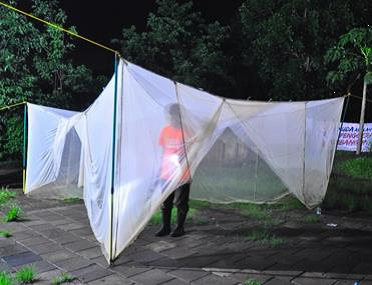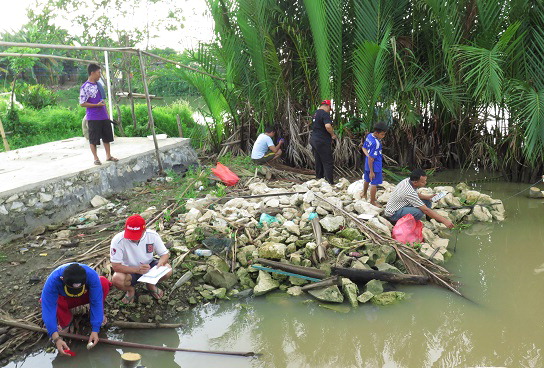During the study period, the team collected a vast amount (50,000+) of mosquito samples from all of main genera: Anopheles, Culex, Aedes and stored them in the laboratory freezer while waiting for the virus control clearances from the CDC collaborator to ensure there were no additional viruses in the mosquitoes. While waiting the virus control, the team analyzed part of the collected samples, with help and donations from local clinicians who commonly encounter patients with endemic dengue. None of the samples appeared to be positive. Unfortunately, it took almost two years for the CDC permit of virus control exportation from the CDC, and the controls arrived in the lab just few month before the end of study period.
Unfortunately, this delay, along with the limited capacity of the freezer, degraded the samples and none of the preserved samples had positive results for arboviruses, despite more than 20.000 tested. As such, the team decided to re-collect samples and chose three sites from the West and South Sulawesi provinces, each with multiple collection windows. The project team managed to collect 16,980 mosquitoes from nine genera and found a Bunyaviridae family positive in one pool of Culex trinaenorhyncus mosquitoes. The sequencing results were Bunyawera virus (BUNV) with 99% percent identity when compared to the NCBI database of Bunyawera viruses. The team is preparing a manuscript on the new report of Bunyawera virus in Indonesia.
The team also developed links with other national and international researchers with the help of their collaborators who had other projects in Indonesia. The team established many national links, both governmental and non-governmental, such as the Ministry of Health (MoH) and its sub-directorate of Vectors, Arboviruses, And Malaria, and the Tahia Foundation, which is developing wolbachia -infected Aedes for dengue control (in collaboration with an Australian university funded by the Bill and Melinda Gates Foundation). The team also connected with international researchers from foreign universities such as: CDC (US)-funded lab in Eijkman Institute (Indonesia), San Diego University (US), Roma Tre University (Italy), St. Andrew University and Surrey University both from UK, Kitasato University (Japan) and Chiang Mai University (Thailand), and also organizations including UNICEF and WHO, to support further mosquito-related research.
This networking resulted in additional national and international research grants from UNICEF (2014-2015, 2018), Militari Health Institute (2015-2016), JSPS Japan (2018-2022), Medical Research Council UK (2018, 2019-2021), and the Ministry of Higher Education, Research and Technology of Indonesia (2019-2020). Several publications were written with the developed network, while several others are waiting for submission and acceptance.
While conducting the activities, the team closely communicated with governmental organization including the MoH, Provincial Health Office (PHO) of South Sulawesi and West Sulawesi, District Heath Office (DHO). These agencies used their influence to help implement study results including helping DHO of Makassar City improve their vector controls for dengue and reduce dengue incidence by about 83%. The team also made an agreement with PHO of South Sulawesi to use Hasanuddin University labs as one of their referral laboratories in case of an infectious disease outbreak and/or investigation of unknown fever causes. The team was also invited to give training to health officers on mosquito-borne diseases diagnostics and vector surveillance of malaria, dengue, and filariasis. They gave training on vector surveillance and mapping to health officer from the eastern part of Indonesia and to military health staff from all Indonesian military regions (KODAM), to Port Health Officers (KKP) representatives from across Indonesia, and to the Primary Health Clinic staff of four tsunami-affected districts in Central Sulawesi, as well as on vector surveillance and mapping. The MoH then appointed the team as panel experts for vectors and malaria, while PHO of South Sulawesi and DHO Makssar City appointed the project team as their vector-borne diseases consultant.
Internally, the team’s research activities also influenced the medical faculty to give more support for medical researches. The new dean decided to involve undergraduate student in ongoing research of their academic staff, adding more budget for research grants for the academic staff, and built a new molecular lab for infectious tropical diseases and animal experiments.
PublicationsAli, Rusdiyah Sudirman Made et al. “Genetic and morphological evidence for a new species of the Maculatus Group of Anopheles subgenus Cellia (Diptera: Culicidae) in Java, Indonesia.” Parasites & vectors vol. 12,1 107. 14 Mar. 2019,
doi:10.1186/s13071-019-3358-2
Nixon, Christian P et al. “Distance to Anopheles sundaicus larval habitats dominant among risk factors for parasitemia in meso-endemic Southwest Sumba, Indonesia.” Pathogens and global health vol. 108,8 (2014): 369-80.
doi:10.1179/2047773214Y.0000000167Sasmono, R Tedjo et al. “Genomic analysis and growth characteristic of dengue viruses from Makassar, Indonesia.” Infection, genetics and evolution : journal of molecular epidemiology and evolutionary genetics in infectious diseases vol. 32 (2015): 165-77.
doi:10.1016/j.meegid.2015.03.006Sutanto, Inge et al. “Negligible Impact of Mass Screening and Treatment on Mesoendemic Malaria Transmission at West Timor in Eastern Indonesia: A Cluster-Randomized Trial.” Clinical infectious diseases : an official publication of the Infectious Diseases Society of America vol. 67,9 (2018): 1364-1372.
doi:10.1093/cid/ciy231Syafruddin, Din et al. “Impact of a spatial repellent on malaria incidence in two villages in Sumba, Indonesia.” The American journal of tropical medicine and hygiene vol. 91,6 (2014): 1079-87.
doi:10.4269/ajtmh.13-0735 




